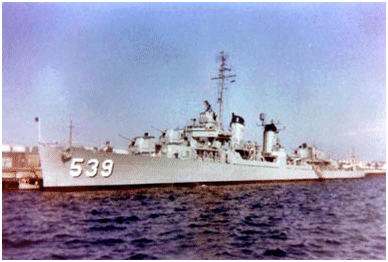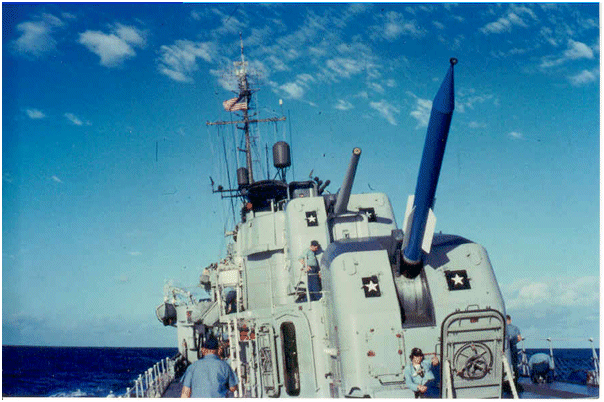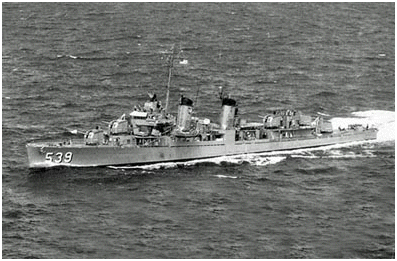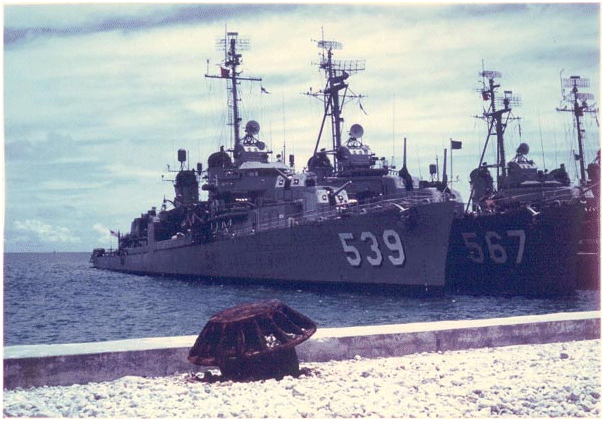(Reprinted with permission from the fall, 2007 issue of Tin Can Sailor)
February, 1962
U.S.S. Tingey (DD 539)
Somewhere near the coast of Honshu, Japan
 Tingey, a 2,100 ton Fletcher class destroyer rolled easily in the calm Pacific under a moonless night. Yesterday, she had emerged from a series of bone-jarring storms that had left us sleepless and walking like zombies. But tonight, the sky was clear and sparkled with stars which gleamed with the blue-white brilliance only seen at sea. We were in station six of a circular formation with the destroyers of DESRON FIFTEEN. At the formation’s center was the carrier USS Bennington (CVS 20) steaming in regal splendor at twenty knots. Without EMCON, our formation’s lights looked rather festive as we closed Japan’s coast.
Tingey, a 2,100 ton Fletcher class destroyer rolled easily in the calm Pacific under a moonless night. Yesterday, she had emerged from a series of bone-jarring storms that had left us sleepless and walking like zombies. But tonight, the sky was clear and sparkled with stars which gleamed with the blue-white brilliance only seen at sea. We were in station six of a circular formation with the destroyers of DESRON FIFTEEN. At the formation’s center was the carrier USS Bennington (CVS 20) steaming in regal splendor at twenty knots. Without EMCON, our formation’s lights looked rather festive as we closed Japan’s coast.
Mix and Match
It was 2000 and we stood for officer’s call on the 01 level before the mast. This gave us the superstructure’s protection, and yet little zephyrs still curled around bulkheads, ruffling our khakis as we swayed with the ship’s motion. Twelve of us stood in two ranks: Department heads in front, junior officers in back. Four other officers were on watch; the captain was in his sea cabin immersed in paper work.
“What is going on?” the Exec demanded.
We looked back dumbly.
“Come on,” the Exec’s Zippo clanked as he lit a Pall Mall. “Anybody? The skipper is worried. And quite frankly, I am too.”
We exchanged glances and shrugs. We’d felt it, too. The crew had been too quiet. For the past few days, they’d silently gone about their jobs with lips pressed, eyes avoiding us as we neared Japan’s coast. Since leaving Pearl Harbor, we’d been at sea for ten storm-tossed days. One would have thought the ship would be rife with channel fever in anticipation of reaching Yokosuka. But even the redoubtable chiefs were unapproachable as they strut about our decks or sat in the goat locker, their arms folded in regal silence.
What is going on? we wondered.
The exec’s eyes narrowed. “Come on. Better to find out now then after we tie up.”
More shrugs.
The exec took a drag off his Pall Mall then looked up, “Let’s try again tomorrow. Now. There’s been a change tomorrow for entering port. Sagami Wan entrance 0800. Yokosuka 0930. Special sea detail, 0845. Any questions?”
Shrugs.
With another drag, the exec turned to the engineering officer. “No smoke going into Tokyo Bay.” He puffed his chest, the unspoken command that he didn’t want our beloved Tingey, a seventeen year old veteran of the Battle of Leyte Gulf, to embarrass us before our squadron flag, the U.S.S. Mahan (DLG 11). For sure, there was animosity between the DLG/DDG crowd and the DDs. Maybe they were jealous of the campaign ribbons on our bridge from World War II and Korea. The Mahan sure didn’t have any.
 It began the previous summer when we’d been fleeted up from a reserve destroyer to become a once-again full-time greyhound of the sea. An international crisis was on in Berlin. Something about the East Germans building a wall through the center of the City. Another crisis was brewing in the Gulf of Siam, so we’d been ordered to re-join the big boys in WESPAC to screen our carriers from the bad guys. They stuffed us into Destroyer Squadron Fifteen that sported twelve destroyers: four were of the fleet’s newest guided missile frigates (DLG); another four were new guided missile destroyers (DDG). The final four was taken up by us and three other Fletcher class destroyers. Compared to the DLGs and DDGs, we were sort of “out there” and treated accordingly. Mix and match.
It began the previous summer when we’d been fleeted up from a reserve destroyer to become a once-again full-time greyhound of the sea. An international crisis was on in Berlin. Something about the East Germans building a wall through the center of the City. Another crisis was brewing in the Gulf of Siam, so we’d been ordered to re-join the big boys in WESPAC to screen our carriers from the bad guys. They stuffed us into Destroyer Squadron Fifteen that sported twelve destroyers: four were of the fleet’s newest guided missile frigates (DLG); another four were new guided missile destroyers (DDG). The final four was taken up by us and three other Fletcher class destroyers. Compared to the DLGs and DDGs, we were sort of “out there” and treated accordingly. Mix and match.
For sure, juxtaposing a Fletcher class alongside a Coontz class guided missile frigate was like parking a model T Ford alongside a Ferrari. The champions of the U.S. Navy were festooned with the latest mods of Tartar and Terrier guided missiles. Also, they had high-tech things like NTDS, ASROC and super-sensitive mark 44 tube-launched homing torpedoes all designed to handle Ivan’s growing submarine threat. This was capped off with new modular CICs, where on-watch sailors defended the fleet in air-conditioned comfort. Even their wardrooms were air conditioned. And we were enroute to the humidity soaked South China Sea. But on a calm day and with a good tail wind, the mighty Tingey did have a thirty knot capability and could maintain fleet speed with the carriers and other brand new destroyers sporting air-conditioned modular CICs.
The corners of the engineering officer’s mouth turned up. “We enter Tokyo Bay in a column, sir?”
The exec raised a clipboard and thumbed aside flimsies. He found a message. “Affirmative. We enter Tokyo Bay in a column.” He smiled back. “We’ll be in last place, again.”
Groans. This meant we’d be the last to tie up and be outboard ship again in a nest of Godzilla-sized guided missile frigates ranging up to 5,800 tons. And we knew they derived a sadistic pleasure out of sticking us outboard in the nest. Getting to the pier meant navigating brass-festooned quarterdecks of these brand-new goliaths, their dress khaki-clad OODs strutting about in officious silence. Worse, it meant that our working parties bringing food and other consumables from the pier had to lug their boxes and crates across three, four, and sometimes five incompatible and oftentimes hostile quarterdecks.
We’d left San Diego about four weeks before making Pearl Harbor in ten days. Fights had broken out the first night ashore in Pearl. Brightwork and canvaswork was stolen off our fo’s’cle. During the next week’s exercises around Oahu, the captain and exec both looked the other way when, relegated as outboard ship, our boatswain’s mates rigged rat-guards after we tied up. This, of course, was the ultimate insult a ship could deliver to another. And it captured the immediate attention of the squadron commodore who ordered our rat-guards stricken. Strangely, it was after that that our brightwork and canvaswork was mysteriously returned. But still, things were tense.
“Yes, sir. Last place in the column. No smoke, Sir,” replied the engineering officer. His tone implied, “what does it matter? If we do make smoke, we’ll be so far back in the column that people on the Mahan’s bridge will never see us anyway.” But he didn’t have to worry. The Tingey, for all her seventeen years and thousands of miles of steaming, still had a tight, well-maintained plant.
With a slight shake of his head, the exec said, “Just make sure, okay?” He flipped more flimsies. “Right. All initialed.” The exec made sure we read and initialed all the messages. With an uncanny expertise, he flicked his cigarette butt over the side — a shot of about seventeen feet. “Dismissed. Movie tonight is Guns of Navaronne.”
Now this is more like it. With an alacrity not often seen, we scampered from the 01 level down to our non-air conditioned wardroom on the main-deck. We were anxious for another showing of Alistair McLean’s best-selling adaptation. It had a great cast: Gregory Peck, David Niven, Anthony Quinn, and Irene Pappas who plays Maria Pappadimos. We’d traded it among the ships of DESRON FIFTEEN on our way from San Diego and had seen this action-packed thriller five times.
We stood as our Captain entered. He seated us with a smile and small talk. Coffee cups rattled in their saucers. The overhead lights were snapped off; the space darkened as Zippo lighters clicked. Immediately, the Bell & Howell sixteen millimeter projector ground into life. Once again, our disbelief was suspended as credits rolled and blue cigar and cigarette smoke swirled before the screen.
We knew most of the lines and after two hours of action-packed nail-biting drama, we are ready for the pay off. At last, thunderous explosion after ear-splitting explosion rack Navarrone as Peck and Niven get the guns blown up. The mountain spews fiery, black detritus for miles around that collapses into the Aegean, the twin German cannons tumbling right behind.
Now for the best part. Gregory Peck and Irene Pappas commandeer a gleaming mahogany Riva speedboat and race offshore to rescue a drowning Anthony Quinn, a victim of a Nazi stab wound. The irony is that Quinn has vowed to kill Gregory Peck after their mission is completed. Now, this is plainly evident as Navaorrone’s massive crater spews fire and smoke.
Pappas skillfully maneuvers the Riva alongside a bleeding, sputtering Quinn. He’s going down for the third time.
Here comes the best part: Irene Pappas jazzes the Riva’s throttle making it sound like a well-oiled, V-16 supercharged engine. With a throaty roar, it goes, “Vroom vroom.” The Riva reminds us of our high school days when we chased girls and did our utmost to buy Smitty glass-pak 26 inch mufflers for whatever cars we could afford.
Peck thrusts out a boat hook to a blubbering Quinn and commands in his signature deep timbre, “Come on, Man. Grab it!”
“… I…I can’t,” Quinn sputters.
“… Vroooom, vroom,” goes Pappas.
“Vroom, vroom, ” we shout back in unison.
“Grab, it!” Demands Peck.
“Grab it,” we shout.
“Vroom, vroom,” goes Pappas.
“Vroom, vroom,” we yell.
An exhausted Quinn barely snags the boathook with a forefinger. Peck drags Quinn aboard. Quinn tumbles into Irene Pappas’ eager arms. British destroyers joyfully hoot their whistles while a choir sings “Maria’s Song” in the background.
We give a last, “Vroom, vroom.”
Finis.
The projector stops, then is threaded for a re-wind. Eyes blink as bright stygian lights flash on in a smoky wardroom, snapping us back to reality. Time for the sack; some of us are up at 2330 for the midwatch.
We stand respectfully, letting the captain exit. He heads down the passage way and ducks into our un-air conditioned non-modular CIC where he’ll study the radars and take in the picture. From there, he’ll climb to the bridge for a last look around before he retires to his sea-cabin.
The exec blocks the exit, lights up another Pall Mall and delivers a withering glance, “Figure out what they’re up to, Okay? And no foul-ups tomorrow. We have to look good for our grand entrance.” He turns and heads for his stateroom below.
* * * * *
The next morning found us under clear blue skies and a calm rolling sea. The wind wasn’t up yet leaving the surface glassy with the consistency of thirty-weight oil. We’d already formed into the dreaded column and once again, Tingey took up the rear as tail-end Charlie. Even so, one could see Mount Fujiyama’s snow capped peak from the bridge. It stood in white misty splendor beckoning right off our bow. Amazing, we’d really made it.
Everyone shook hands with the Exec at officer’s call on the quarterdeck. He doubled as our navigator and guffawed with, ‘Aw shucks,’ tongue in cheek, knowing that he didn’t have any choice but to follow eleven destroyers and a great big fat carrier. But we knew he’d been out there taking his morning stars and sun lines, verifying our position.
Thus, with a smattering of pride, he raised the plan of the day and began to read. “Now lissen up. We’ll man the rail at 0900 and I want everyone-“
A palm went to his forehead. “What the–?” He looked from side to side and then called to the Operations officer. “Get the yeoman up here on the double.”
“Sir, anything wrong?” The yeomen were in the operations department.
“You better believe it.” He shoved the plan of the day under the Ops officer’s nose.”
“…, Sir, I don’t… holy smokes!”
“What’s going on?” The Exec jabbed a finger at the top of the page.
We yanked copies from our pockets and discovered what we hadn’t noticed during a hurried breakfast. The masthead clearly read: U.S.S. Tingey (DDG 539).
“Whose joke is this? I’ll have that yeoman busted to seaman deuce,” roared the Exec.
The chief engineer, wearing signature oil spattered overalls and garrison cap, popped up from the aft fireroom hatch, about thirty feet aft from where we stood. Deliberately ignoring officer’s call, he turned aft and sauntered toward the fantail, flashlight in hand. The Exec was still muttering about the DDG flap when our chief engineer quickly walked forward and joined our ranks, an enormous grin glowing like the fires in his Babcock and Wilcox boilers.
The Exec demanded, “What’s so funny?”
“Sir, I just discovered why we’re a DDG.” He nodded aft.
“If you’d be so nice as to let me in on your little secret,” The Exec said with evident sarcasm.
“I think you should take a look, Sir.” The Chief Engineer again nodded aft.
“Stand fast.” With doubled fists, the Exec walked aft. Sixty seconds later, he was back, his grin as big as the Chief Engineer’s. “You had all better take a look.”
So we did.

The shipfitters had made a guided missile from plain sheet metal and fitted it over the entire length of mount 55, our after five-inch gun mount. It was replete with fins and nose cone. Like the fleet’s Terrier and Tartar missiles, the body was painted a deep blue, the fins white. A black toilet plunger was fixed to the tip.
“For sure this beats rat-guards,” the Exec growled. “We’ll enter port just as she is and watch ‘em get apoplexy.”
* * * * *
We entered port and our guided missile lasted just two days. The squadron commodore ordered it stricken, saying something about an affront to Japanese sensitivity. Like a first class boatswain’s mate busted to seaman second, we were stripped of our hard-earned DDG status and relegated back to being a common DD.
But there’s a happy ending. Two weeks after that, we were transferred into the welcoming arms of DESRON ONE. We thought this was pretty cool since DESRON ONE’s stack insignia was the first-place rosette logo of Pabst Blue Ribbon beer and our skipper was Commander J. R. Pabst.
We were sent to the South China Sea where we endured the humidity in our un-air conditioned CIC and wardroom to say nothing of the mess decks and sonar shack. We really didn’t have time to think about it, as we were at twenty-five to thirty knots day and night plane-guarding for the U.S.S. Hancock (CVA 19) around Yankee station. And we looked for Communist submarines We actually found a live one and held him down for three days — all with out the benefit of a modular air conditioned CIC, to say nothing of our stuffy, oftentimes claustrophobic sonar shack.
We came of age while chasing Hancock around Yankee Station. Even without air-conditioning, our World War II battle-hardened Tingey took care of us and brought us home to our families. We pulled it off. Amazing.
 That was forty-five years ago. The Tingey is gone now; long ago expended as a target off San Clemente Island. But I think fondly of her and my shipmates as Turner Classic Movies once again rolls The Guns of Navaronne It still takes two hours but finally, the end is near and I get to go, “vroom, vroom,” while my wife sits there with folded arms, shaking her head and rolling her eyes.
That was forty-five years ago. The Tingey is gone now; long ago expended as a target off San Clemente Island. But I think fondly of her and my shipmates as Turner Classic Movies once again rolls The Guns of Navaronne It still takes two hours but finally, the end is near and I get to go, “vroom, vroom,” while my wife sits there with folded arms, shaking her head and rolling her eyes.
